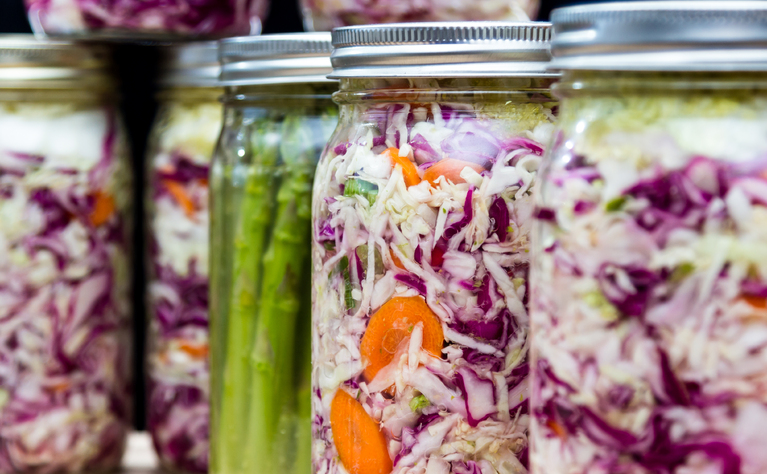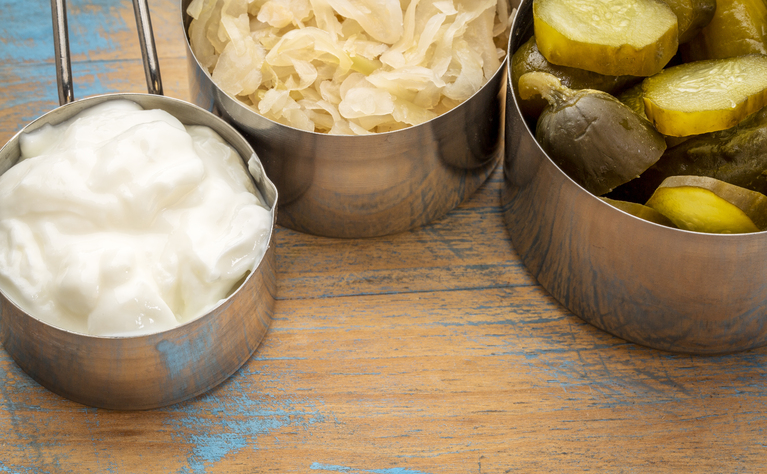
Probiotic foods are foods said to contain live and active bacteria which when eaten populate our gut. Find out everything you need to know about probiotic foods in this article.
The theory behind probiotic foods is that they contain live and active bacteria. When eaten this bacteria is said to populate our gut and hopefully goes on to thrive in our bodies. There are lots of reported health benefits in having a diverse and healthy microbiome and advocates of probiotic food say it helps to achieve this and there is research to support this too.
Many of the probiotic foods are made by using a fermentation process. Fermentation creates the perfect environment for bacteria to grow, thrive and survive. Our ancestors used to ferment a lot of food to stop it from spoiling. Now, with modern refrigeration, we no longer routinely ferment foods. Some people say this change means we are no longer getting as much of the good bacteria for our guts that our ancestors got.
It is difficult to measure exactly how much bacteria there is in fermented food and if any of this bacteria reaches our gut.
Yogurt is made from milk which has been fermented by friendly bacteria. Some yogurts contain more live bacteria than others so always read the label. Look for ones which say 'live and active cultures'. Also choose yogurts that are natural and don’t contain added sugars or flavourings. Contains dairy.
Kefir
Kefir is a fermented drink which is often made from milk, water or coconut milk. It has a very distinctive taste! It has been eaten for around 3,000 years. To make it kefir grains (cultures of lactic acid bacteria and yeast) are added to the liquid and left for a few days to ferment. A study has shown that kefir can actually help improve lactose digestion in those who are intolerant1. Read more about kefir and IBD. You can easily make your own milk kefir using this recipe.
Pickles (gherkins)
The naturally occurring lactic acid bacteria in cucumbers means that when they are adding to water and salt and left they ferment to create pickles (also known as gherkins). Make sure you buy varieties in brined water and sea salt instead of vinegar as ones in vinegar do not contain live probiotic bacteria.
Sauerkraut
Sauerkraut is fermented cabbage. When finely chopped and added to water and salt it ferments to create sauerkraut. Many supermarket varieties will have been pasteurised and this kills off the good bacteria so if you are buying from a shop make sure to choose an unpasteurised product. It's also really easy to make yourself using this sauerkraut recipe.
Kimchi
A Korean side dish made from fermented cabbage, cucumber or radish. It's flavoured with things such as chilli pepper flakes, garlic, ginger and sale and can often be spicy! It contains Lactobacillus kimchii as well as other probiotic strains.
Kombucha tea
An effervescent fermentation (using bacteria and yeast) of black tea or green tea. It originated in Japan and has been around for around 2,000 years. It is sold in in many Asian grocery stores.
Miso
Miso is a Japanese seasoning made from soybeans which are fermented using salt and a fungus called koji. It’s commonly used in Asian cooking and is used to make miso soup.
Tempeh
Tempeh is high in protein and is often used as a meat substitute. It originates from Indonesia and is made from fermented soybeans.
Natto
A popular food in Japan made from fermented soybeans. It contains a bacteria strain called Bacillus subtilis.
Kvass
Kvass is a popular fermented drink in eastern Europe. It has a taste similar to beer and is commonly made from stale, sourdough rye bread - though can also be made from fruits or beets. Flavours, such as fruit and herbs, may be added to it.

A review in 2016 looked at comparing food and supplements as probiotic delivery vehicles and concluded that “although both foods and supplements seem to have been efficient carriers for the beneficial bacteria, to generally promote public health in communities, probiotic foods appear to be preferred to probiotic supplements2.”
Probiotic or fermented foods are appropriate for most people and can form part of a healthy balanced diet. On the other hand, probiotic supplements may not be appropriate for everyone. Specific strains of probiotics have been researched for specific conditions so just taking any probiotic or a multi strain probiotic may not have the desired effect. Caution should be taken around taking probiotics when you are on immunosuppressant medications or are acutely unwell - always speak to your doctor before starting a probiotic to check it is safe for you to do so.
Here are some of the things you may want to consider when deciding which may be best for you:
Some people find the increase in bacteria difficult and experience intestinal symptoms. This may be due to a condition called small intestinal bacterial overgrowth (SIBO) in which the bacteria which should be in your colon is actually living in your small intestine.
If you do find you are experiencing issues then you may want to try eating small amounts of probiotic foods at first and slowly increasing the amount.
If you are pregnant you should be wary of eating any unpasteurised food - speak to your doctor before doing so.
It is also important to remember if you are making your own probiotic food that you cannot know what bacteria is in it.
Researchers are starting to think that imbalances in our gut microbiome are linked to many diseases, ailments and even our mental health.
There is increasing evidence that suggests intestinal microbiota plays a role in initiating, maintaining and determining the characteristics and development of IBD3, 4. And, some people with IBD do report that taking probiotics can help with easing some of their symptoms.
However, studies into the effectiveness of probiotics on people with IBD are limited.
One small clinical trial in 2018 looked at the impact of kefir on IBD. It showed that taking kefir may help with symptoms of bloating in people with Crohn’s Disease and may help to reduce inflammation5.
If you are feeling adventurous you could try making your own probiotic foods. Here are some recipes for sauerkraut and milk kefir.